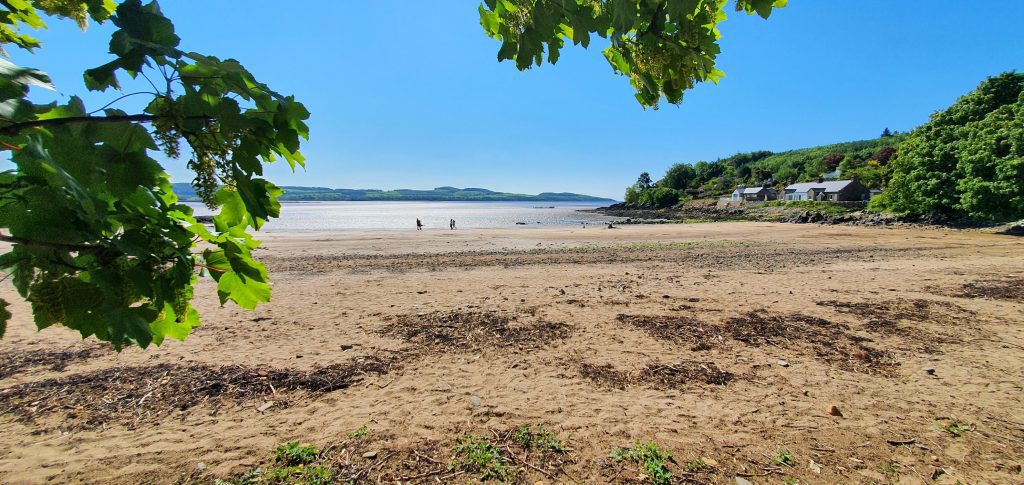- 98% of Scotland’s bathing waters pass environmental standards:
- 38 (44%) of bathing waters will be rated ‘excellent’ for 2023 – the highest since tighter standards first came into force in 2015.
- 47 (54%) will achieve ‘good’ or ‘sufficient’ status for 2023
- Two (2%) will have ‘poor’ status for 2023
- Previous projects to improve water quality are now showing sustained improvements across Scotland.
- Ayr (South Beach) maintains ‘good’ status following significant improvements over many years.
- Management plans at Dhoon Bay improved water quality in 2022.
- Projects are in development for the two ‘poor’ Fife beaches to improve water quality
- Farmers and land managers have continued to show good compliance with environmental regulations.
- Targeted investments by Scottish Water have helped to reduce risks and improve water quality.
Since 2015, 15 bathing waters have improved their classification from ‘poor’ to ‘sufficient’ or better. This is testament to the on-going partnership working taking place to drive forward water quality in Scotland. Whilst next year two bathing waters will have a ‘poor’ classification, the Scottish Environment Protection Agency (SEPA) intends to drive the same improvements that have successfully been achieved at other sites.
Scotland’s results(*):
| 2022/23 | 2021/22 | 2020/21 | 2019/20 | 2018/19 | 2017/18 | 2016/17 | 2015/16 | |
| Excellent | 38 (44%) | 32 (38%) | Results carried over | 29 (34% | 28 (32%) | 25 (29%) | 26 (31%) | 17 (20%) |
| Good | 35 (40%) | 35 (41%) | 31 (36%) | 35 (41%) | 34 (40%) | 36 (43%) | 38 (45%) | |
| Sufficient | 12 (14%) | 17 (20%) | 20 (24%) | 13 (15%) | 16 (19%) | 11 (13%) | 12 (14%) | |
| Poor | 2 (2%) | 1 (1%) | 5 (6%) | 10 (12%) | 11 (13%) | 11 (13%) | 17 (20%) | |
| Total | 87 | 85 | 85 | 86 | 86 | 84 | 84 |
Sources of pollution at Scotland’s bathing waters are often complex and interlinked, requiring action from a range of organisations and people. Progress is being made through working with partners and communities to coordinate activities and identify actions to address water quality challenges, particularly around diffuse pollution, sewage and urban sources.
One of Scotland’s most popular visitor areas, Ayr (South Beach), will maintain its ‘good’ status, achieved in 2021/22, following targeted improvement actions to reduce pollution. The status of the water quality is the result of several years of partnership working between SEPA, Ayrshire livestock farmers and Scottish Water, supported by South Ayrshire Council and the Scottish Government. These improvements were significant and there is good confidence that a similar classification should be maintained in future years.
Dhoon Bay has achieved ‘sufficient’ status for 2023. Rated ‘poor’ for the last four years, the improved water quality is a result of targeted action. This involved partnership working between the local community and tourism businesses, Scottish Water, and the local authority and focused on improvements to the treatment of private sewage as well as reducing run-off from agricultural land. The Scottish Government provided funding to address inputs from private sewage treatment systems. This work is ongoing.
Other long-term projects
At Sandyhills, in Dumfries and Galloway, SEPA worked with farmers and NFU Scotland to tackle issues related to diffuse pollution, leading to sustained improvements to water quality. Having previously been rated ‘poor’, Sandyhills has achieved two successive ‘good’ classifications and will be rated ‘good’ again in 2023.
Heads of Ayr in Ayrshire has achieved an ‘excellent’ and ‘good’ classification in the last two seasons, following ‘poor’ classifications in previous years. It will maintain its ‘good’ again in 2023. It has seen investment in sewage treatment, surface water drainage and farms complying with requirements. This has resulted in significant water quality improvement.
The Nairn Central and Nairn East bathing waters will be rated ‘good’ for 2023. These sites have had consistent ratings since passing in 2018. Having been a priority project, progress was made through working with partners and communities to coordinate activities and identify actions to address water quality challenges, particularly around diffuse pollution, sewage and urban sources.
Luss Bay will be ‘sufficient’ for the 2023 bathing season and improvements in the water quality in what is a very popular area for visitors will be taken forward by SEPA with partner organisations including Argyll & Bute Council, the Luss Estate, Loch Lomond and the Trossachs National Park Authority, Scottish Water, local businesses and residents.
Scotland had two newly designated Bathing Waters in 2022.
Barassie in Ayrshire achieved a ‘sufficient’ classification, while Lower Largo, in Fife, will be rated as ‘poor’ for the 2023 bathing season. A Scottish Water project at Lower Largo has been assessing potential sources of pollution into local burns, including testing for misconnections in nearby properties. SEPA will continue to monitor and report water quality and determine how best to drive water quality improvements over the next few years.
Kinghorn (Harbour Beach) will be rated as ‘poor’ for 2023, following ‘sufficient’ classifications in 2019 and 2021. SEPA is carrying out investigations and further monitoring is planned. SEPA will work with partners to identify and resolve issues.
Ruth Stidson, SEPA’s Principal Scientist for Bathing Waters, said: “Seeing the long-term bathing water quality improvements reflected in this year’s results demonstrates that the sustained hard work by public bodies, private businesses and communities has made a real improvement across Scotland.
“More of our bathing waters will be rated ‘excellent’ than ever before and, overall, 98% are meeting strict environmental standards. We have the largest number of designated bathing waters on record which is good news for the increasing popularity of wild swimming and the communities, businesses and visitors who enjoy our coastlines.
“This has demonstrated the success of driving improvements in water quality through targeted regulation and partnership working. SEPA will continue to work to protect and improve water quality across Scotland with a range of stakeholders, including local authorities, public bodies, farmers and local communities and businesses. We will use our expertise to provide advice and guidance, recommend actions and – when it is appropriate to do so – take robust enforcement action.”
Environment Minister Mairi McAllan said: “Scotland’s bathing waters are not only important to our environment, they provide spaces for recreation and contribute to good health and well-being. That’s why it’s so great to see more bathing waters across the country rated excellent than ever before.
“The number of bathing waters in Scotland has increased since last year and now stands at 87, with 98% achieving the bathing water quality standards.
“By investing in improving bathing waters across Scotland, we have made sure many more people – tourists and locals alike – can continue to enjoy them, which is good for our communities and our local economies.”
Simon Parsons, Director of Strategic Customer Service Planning, Scottish Water, said: “Scottish Water is committed to continuing to support the protection and improvement of Scotland’s rivers, coastal waters and beaches.
“Last December, we published our improving urban waters route map announcing plans to invest up to half a billion pounds more in Scotland’s waste water network to deliver further improvements and ensure that Scotland’s rivers, beaches and urban waters are free from sewage related debris.
“Our customers can play a huge part in preventing debris in rivers and on beaches. Our national campaign ‘Nature Calls’ urges customers not to flush wet wipes (and other items) down the toilet and we are calling for a complete ban on the sale of wet wipes containing plastic.”
Working with farmers to improve Scotland’s rivers
SEPA has been working alongside NFU Scotland over a number of years to help farmers and rural land managers across Scotland reduce diffuse pollution.
This has been an issue affecting both Ayrshire and Rockcliffe bathing water catchments. In the Ayr (South Beach) bathing water catchment there are only a handful of farms SEPA is still working with to achieve compliance. All others are fully compliant, with many adopting new practices and spending significant sums of money to improve slurry storage, fence off water courses and install alternative water supplies for livestock. Around £50 million has been spent on improvements in Ayrshire’s Bathing waters, through self-funding and grants from Scottish Government, and in many cases, farmers have gone even further than is legally required to help protect Scotland’s water environment from farming activities.
In 2022, SEPA issued a farmer with a £600 fixed monetary penalty for a failure to comply with or contravene a General Binding rule. The farmer, who had previously been compliant, failed to prevent significant erosion or poaching of land within 5m of the Corraford Burn, which is within the Dhoon catchment.
Bathing water quality monitoring and prediction
Scotland has some of the most beautiful beaches in the world, but also experiences some of the wettest weather in Europe. Heavy rain can have an impact on water quality at bathing waters due to pollutants being washed into rivers from sewage treatment systems, roads and pavements.
Scotland’s official bathing water season runs between 1 June and 15 September. Throughout the season, SEPA’s specialist teams sample the designated waters providing regular water quality information which is published on the SEPA website. Pre-season sampling is carried out during May. Monitoring water quality in this way means SEPA can provide information on water quality for bathing and develop a strategy for any water quality improvements needed.
Electronic messaging signs, at selected bathing waters across Scotland, provide real-time predictions of water quality during the season.






